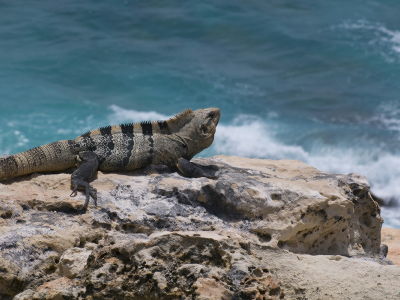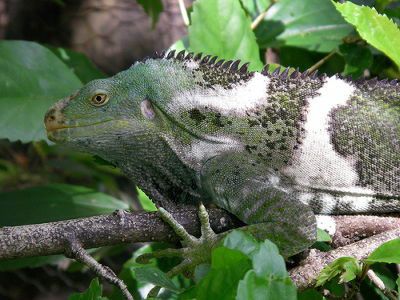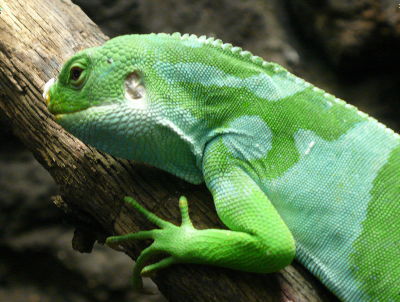How did iguanas cross the ocean? It seems that the long-standing controversy of "drifting" VS "walk" will be settled

It is mainly distributed in the AmericasiguanaHow, in the South PacificFijiYaTongaThe scientists have twisted their heads over the years, as they have become distributed like enclaves on the islands of the islands.
The theory that the ancestors of Iguana inhabiting Fiji and Tonga are currently drifting drifting from South America has been the most influential so far, but the latest research may overwhelm this theory Hmm.
Details are as below.Raft or bridge: How did iguanas reach tiny Pacific islands?
Currently live in Fiji and TongaFiji IguanaHas crossed the Pacific Ocean from South America about 13 million years agoGreen iguanaIt is thought that it evolved.
Biologist at the University of MississippiBrice P. NoonanAssociate ProfessorBrigham Young UniversityofJack W. SitesDue to the latest genetic and geological data and fossils, the iguanas did not drift in the Pacific, but Fiji and Tonga stillSuper continentWhen it was part of it, I thought that it was highly likely that I walked over. Thesis isThe American NaturalistIt is published in January 2010 issue of magazine.
Fiji IguanaFiji Crested Iguana. It was once distributed in 14 islands in the western part of the Fiji Islands, but only three islands have been confirmed now.IUCN Red ListIt is classified as "Critically Endangered" (on the verge of extinction).

Photo: Michael needs more photo time
Fiji Banded Iguana. This was also habitat destruction of the environment, brought to the island wildmongoose· It is threatened by cats etc., and it is "Endangered" on the red list.

"The distribution of several iguanas in Fiji and Tonga is" one of the most difficult mysteries to understand in island biogeography, "Associate Professor Noonan. Ignana is not distributed at all in other South Pacific islands other than Fiji and Tonga and in the Australia which is the closest (about 3000 km) continent, you have to go to the South America that is 5000 miles (about 8000 km) away from the Pacific Ocean You can not see other iguanas. So how did Iguana reach the distribution in Fiji and Tonga?
The past common opinion was that it would have drifted from South America drifting in the Pacific Ocean. There are other examples in which the iguana drifted and spread the distribution, and the islands of the Caribbean Sea and the Iguanas of the Galapagos Islands are believed to have drifted from driftwood and so on from the mainland of South America, but crossing the Pacific Ocean, The scale is totally different. Dr. Noonan and Dr. Sites estimate it will take more than six months to cross the Pacific Ocean. It is a long period of time for iguana to survive on vegetation like driftwood and small floating islands.
So Dr. Noonan and Dr. Sites, iguana and the islands still haveGondwana continent(Part of today's Africa, Australia, Antarctica, Asia, including Asia), we verified the possibility of moving the habitat by walking. In that case, Fijian and Tongan iguanas are very old species. Existing iguana DNAMolecular ClockAs a result of the analysis, it turned out that Fiji Iguanas branched out from other genera more than 60 million years ago. 60 million years ago, Fiji and Tonga still haveA crossoverIt was an era when I was connected to Australia and Asia.
Fossil evidence also supports this hypothesis. The fossils excavated in Mongolia have revealed that the ancestors of Iguana were distributed in Asia in the past as well. In Australia fossils of iguanas have not been discovered so far, but the possibility of being distributed in the past has not been denied. According to Noonan et al., The fossil record of the Australian continent is surprisingly poor, and the absence of fossils can not be taken as proof of absence of past creatures.
If the iguana crossed the overpass from Asia and Australia, it is natural to think that it should be distributed also in the surrounding Pacific islands which were part of the overpass, but now Fiji and Tonga Why is it that the iguanas do not inhabit the South Pacific islands of South Africa? Fossil evidence suggests that Iguana was distributed in other islands in the past, but it was suggested that it was extinct when human beings lived on those islands. Fiji and Tonga compared the surrounding islands with a shallow history since humans began to live, and it can be thought that the iguana was not extinct.
Together with molecular clock and fossil evidence, "AustralasiaContinental fragments ofContinental fragment), It is suggested that iguana reached Fiji and Tonga ", Dr. Noonan says. "Ikada may have been land" Ikada "was on land."
Although the "drifting theory" was not completely excluded by this research, the "walking theory" was shown to be a much more legged theory to the ground than previously thought.
Related Posts:
in Science, Posted by darkhorse_log







